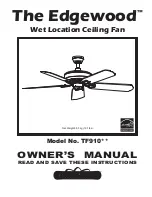
Unitary Products Group
27
246681-YTG-B-0607
OPTIONS
Optional UERV Equipment Support
Furnish and install the optional equipment support for the
intake and exhaust end of the unit.
Optional Roof Curb
Furnish and install the optional roof mounting frame to main-
tain proper height above the roof.
Optional Low Ambient Kit
Furnish and install the optional low ambient kit to prevent
frost formation on the energy recovery wheel.
Optional Motorized Intake Air Damper
Furnish and install the optional motorized intake air damper.
Optional Stop-Start-Jog
On units without economizers furnish and install the optional
stop-start-jog controls.
SEQUENCE OF OPERATION:
Fixed Models - Normal Operation
1.
The space thermostat sends a signal to the RTU for cool-
ing, heating or fan only operation.
2.
The ERV is activated simultaneously with the supply
blower of the RTU. The intake blower, the exhaust
blower, and the wheel rotation motor of the ERV are acti-
vated. These motors will remain energized as long as
the supply blower on the RTU is energized. The RTU is
in standard (non-economizer) mode.
3.
If the optional motorized fresh air damper in the outside
air intake of the ERV is present, it opens and the ERV is
energized.
4.
If the optional low ambient kit is present, and the temper-
ature leaving the exhaust side of the wheel drops below
the field adjusted set point on the temperature sensor of
the low ambient kit, the optional motorized fresh air
damper will close and the intake blower will de-energize.
The exhaust air blower and wheel rotation motor will con-
tinue to operate. When the temperature sensor has a
sixteen-degree rise, the wheel is defrosted and the
optional motorized damper will open and the fresh air
blower will reactivate.
Pivoting Models - Normal Operation
1.
The space thermostat sends a signal to the RTU for cool-
ing, heating or fan only operation.
2.
The ERV is activated with the supply blower of the RTU.
The intake blower, the exhaust blower, and the wheel
rotation motor of the ERV are activated. These motors
will remain energized as long as the supply blower on
the RTU is energized and the RTU is in standard (non-
economizer) mode.
3.
If the optional motorized fresh air damper in the outside
air intake of the ERV is present, it opens and the ERV is
energized.
4.
If the optional low ambient kit is present, and the temper-
ature leaving the exhaust side of the wheel drops below
the field adjusted set point on the temperature sensor of
the low ambient kit, the optional motorized fresh air
damper will close and the intake blower will de-energize.
The exhaust air blower and wheel rotation motor will con-
tinue to operate. When the temperature sensor has a
sixteen-degree rise, the wheel is defrosted and the
optional motorized damper will open and the fresh air
blower will reactivate.
Pivoting Models - Economizer Operation
1.
The space thermostat sends a signal to the RTU for cool-
ing operation.
2.
The outdoor air sensor for the RTU senses the outdoor
air and determines it is appropriate for economizer oper-
ation.
3.
As the economizer outside air dampers open, the ERV
economizer end switch is activated sending a signal to
the ERV that the system is in the economizer mode.
4.
The intake blower, the exhaust blower and the wheel
rotation motor all deactivate for up to two minutes. The
optional motorized fresh air damper (if present) also
closes.
5.
The ERV enthalpy wheel pivots out of the air stream and
the bypass dampers along each side of the intake blower
open.
6.
After a time delay to allow the wheel to pivot out of the
airstream and the bypass dampers to open, the optional
motorized fresh air damper opens to allow for full econo-
mizer operation, and the exhaust blower is reactivated to
provide power exhaust for the system.






































